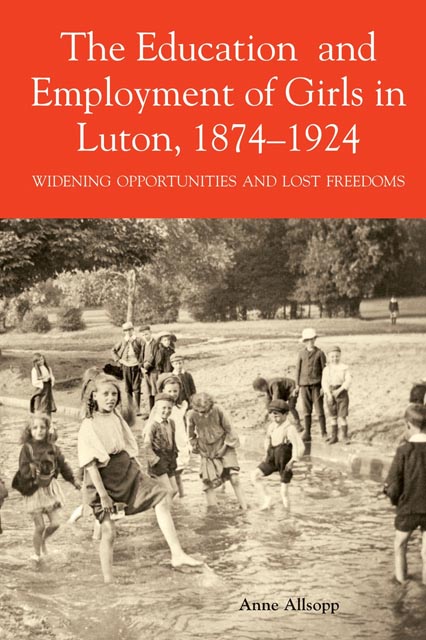Book contents
- Frontmatter
- Contents
- List of Illustrations
- List of Tables
- Dedication
- Acknowledgements
- Abbreviations
- Introduction
- Chapter One Luton: Scientiae et labori detur
- Chapter Two Further Perspectives Concerning Employment Patterns for Women
- Chapter Three Sunday Schools
- Chapter Four Education in the Time of the School Board
- Chapter Five Teaching: An Alternative Occupation
- Chapter Six Teacher Training and the Education of Students Aged Over Fourteen Under Bedfordshire County Council
- Chapter Seven Elementary Education 1903–1924
- Chapter Eight Rural Schools
- Chapter Nine Learning and Living
- Chapter Ten Secondary Education for Girls
- Conclusion
- Appendix
- Bibliography
- Index
Chapter Two - Further Perspectives Concerning Employment Patterns for Women
Published online by Cambridge University Press: 03 August 2023
- Frontmatter
- Contents
- List of Illustrations
- List of Tables
- Dedication
- Acknowledgements
- Abbreviations
- Introduction
- Chapter One Luton: Scientiae et labori detur
- Chapter Two Further Perspectives Concerning Employment Patterns for Women
- Chapter Three Sunday Schools
- Chapter Four Education in the Time of the School Board
- Chapter Five Teaching: An Alternative Occupation
- Chapter Six Teacher Training and the Education of Students Aged Over Fourteen Under Bedfordshire County Council
- Chapter Seven Elementary Education 1903–1924
- Chapter Eight Rural Schools
- Chapter Nine Learning and Living
- Chapter Ten Secondary Education for Girls
- Conclusion
- Appendix
- Bibliography
- Index
Summary
This chapter will look at specific information regarding the employment of women. The 1911 and 1921 censuses give detailed figures and these have been compared with national figures and statistics for Bedford. Less exact, but of interest from a social point of view, are details taken from the Kelly's Directories for 1890 and 1920. Advertisements in the Luton News between 1901 and 1924 indicate general trends and are of value in the assessment of attitudes and expectations. Year Books have also provided useful information and it has been possible to make some comparisons concerning wages and salaries.
Observations based on the 1911 and 1921 censuses
The 1911 and 1921 censuses show just how employment for women had diversified since the height of the hat industry and the arrival of the new industries. The number of unemployed females in 1921 also indicates that some women preferred to remain at home after the First World War. Figures for Bedford have been noted because they offer a contrast to the types of employment available for women in Luton.
While the female population of Luton had increased between 1911 and 1921, the number and proportion of women employed fell. In some respects this supports Carol Dyhouse's view that ‘the first world war only temporarily increased women's participation in industry, and was followed by a period of intensified social opposition to the employment of married women in industry and professional life’. However, the involvement of women in the new industries seems to have risen, as indicated by the proportion involved with metal, food and chemical production. Significantly, the number of women involved with the hat industry fell from 6,972 (63.5%) in 1911 to 5,992 (59%) in 1921. As women had always worked in the straw industry, there would appear to be no ideological explanation. It is more likely that market forces and the First World War, which had affected export markets, rather than ideology accounted for this drop.
Interesting comparisons can be made between Luton and Bedford. A larger proportion of Bedford's female population was involved in the service industries indicating that the town enjoyed a different social structure, with many families able to employ domestic help. Fewer Bedford ladies worked, although there were significant numbers involved in commercial and public life. By 1921, more Bedford women were working in the food and drink industry, for example at Meltis.
- Type
- Chapter
- Information
- The Education and Employment of Girls in Luton, 1874-1924Widening Opportunities and Lost Freedoms, pp. 33 - 45Publisher: Boydell & BrewerFirst published in: 2023



